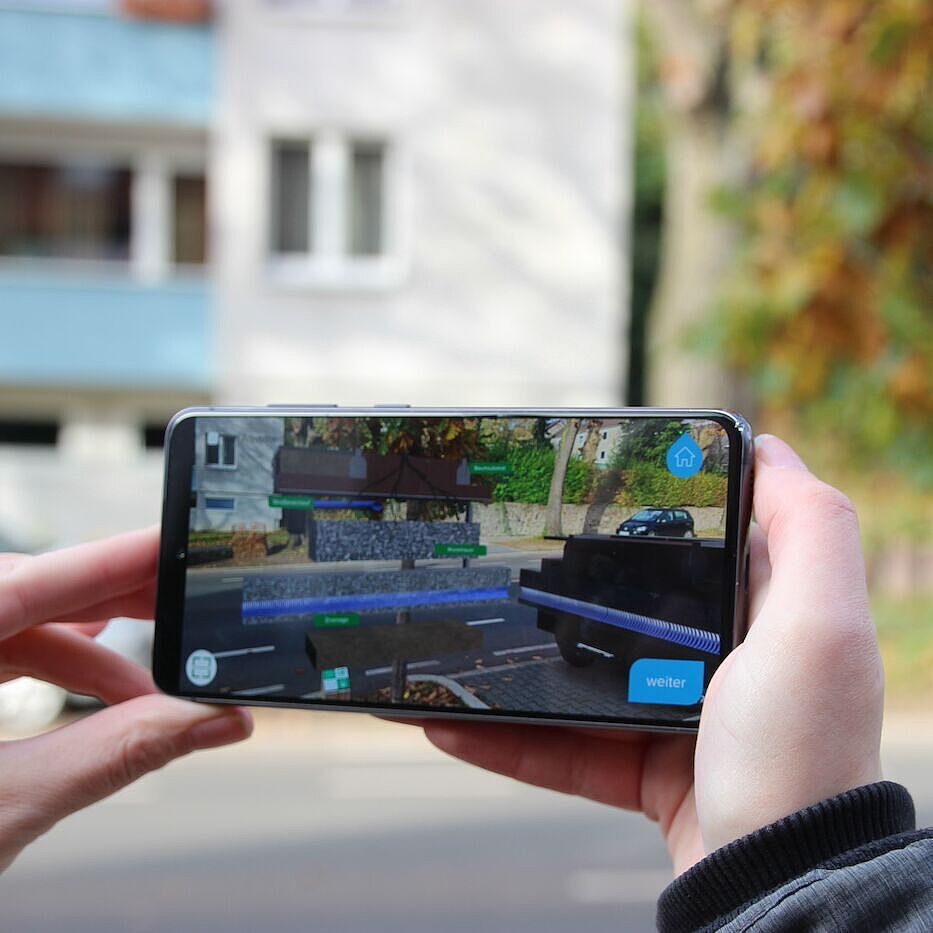Download
The KlimAR app is compatible with mobile phones that support AR. Please note: The app is available in German.

The correct use of rainwater is an important aspect for the climate adaption in our region. The cities in the Ruhr area are implementing multiple measures already, but these are often invisible to citizens as the technically complex systems are often hidden underground. KlimAR.Werk, the new Klima.Werk-app using augmented reality, allows citizens to explore climate adaption measures in mixed reality on their smartphones and to virtually adapt their homes and gardens to the consequences of climate change.
Urban water management has long played a central role in adapting cities to the consequences of climate change. The increase in extreme weather conditions like heavy rainfalls or droughts poses new challenges for the water management. The aim is to reorganise the cities in such a way that they are protected from flooding during heavy rainfall but at the same time store stormwater for use during dry periods.
The cities are implementing targeted measures to achieve this, but the issue also affects homeowners. Accordingly, the KlimAR.Werk offers two main topics: In the section “Klimaanpassung.Stadt”, users can view drainage projects from the cities, initially from the city of Bochum. In the section “Klimaanpassung.Privat”, users can find specific ideas and tips on suitable adaptions to apply at their own property or home.
For this purpose, the app uses augmented reality technology, in short: AR. As such, the app supplements real situations with virtual elements in real time. In other words, the users of the KlimAR.Werk app can, for example, take a look at how tree trenches work in Bochum. Usually, the underground storage tanks are not visible. The app uses the mobile phone camera and supplements the current camera image with visual elements such as texts, images and graphics. This creates a kind of mixed reality.

Augmented reality allows us to visualise things that are usually hidden. This is often the case for drainage systems, as they are either underground or don’t even exist yet.

Michael JeskulkeProject manager in the Klima.Werk service organisation at Emschergenossenschaft
The project at the Wasserstraße in Bochum, whose system of interconnected tree trenches is shown in the KlimAR.App, is a good example of climate adaption. Tree trenches are planting areas for trees that are equipped with an underground storage structure for rainwater. In dry periods, the trees at the street can thus be supplied with water for a longer period. All the tree trenches along the Wasserstraße are interconnected, so that water which can no longer be stored can be discharged into the Marbach.
Citizens can use the app to precisely track the path of the water during a tour on site. They learn about the positive effects of the measures on the environments through estimation questions and other playful elements.
The section “Klimaanpassung.Privat” also makes use of augmented reality. Here, users can explore a sample property as a 3D table model: The app can be used to virtually place the model on your desk at home, for example. The model presents measures for rainwater management that homeowners can use to adapt their building or property to the effects of climate change. The model can be explored interactively in the AR view.
In the app, interested parties can also virtually try out various measures on their own home. For example, the app can simulate what a driveway would look like if it were unsealed and fitted with infiltration-capable paving. The app can also visualise the climate-resistant adaption of gardens and green facades by positioning corresponding virtual elements on your own home.
The implementation of the app has cost 170,000 euros. The Ministry of the Environment of North Rhine-Westphalia is covering 80 per cent of the costs as part of the funding programme “KRiS - Klimaresiliente Region mit internationaler Strahlkraft” (Climate-resilient region with international appeal). 20 per cent are covered by the Emschergenossenschaft. The city of Bochum is supporting the realisation of the project.
Copyright ©
Images: Klima.Werk/EGLV, City of Bochum